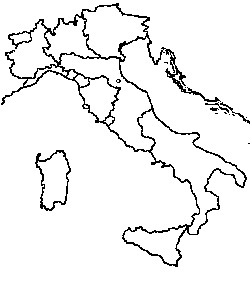To start your research you simply need:
- a name and a surname:

- a place of origin:

Sources
|
Overview of Record LocationsPrior to the the Unification of Italy (1860-70) there was no a central system of administration: each of the states that lately formed the Italian Kingdom had a different system of administration for cadasters, fiscal records, censuses, vital records, etc. This is a broad outline of the various repositories. |
|
|
Publications
Introductory Books and Bibliographies
A good book to begin with is Guide to Jewish Italy by Annie Sacerdoti, Israelowitz Publishing, Brooklyn 1989 (English translation by Richard F. De Lossa, of the original Guida all'Italia Ebraica, Ed. Marietti, Genova 1986). This book contains information on the main Jewish communities of Italy: for each community, there is information on the community's history, its synagogues, cemeteries, museums, libraries, and cultural centers.
Unfortunately the few manuals on the subject of genealogy approach the research as if Italy was always one unified country. No one discusses the specific administrative systems of the little states that later formed Italy.
Most of the books on Italian genealogy are in Italian, and few have lists of family names. They are the only indexes to the original and more detailed resources. You'll find in these pages a bibliography for the genealogical needs.
In English, there is Finding Italian Roots: The complete guide for Americans, by John Philip Colletta (Genealogical Publishing Co., Baltimore 1993), where there are some pages (pages 87-93) pertaining to Jewish genealogical research. .
Sephardic Genealogy. Discovering Your Sephardic Ancestors and Their World by Jeffrey S. Malka, Avotaynu 2003, devotes some pages (207-214) to Jewish genealogy in Italy.
The first bibliography on Italian Jewish history mentions about 750 publications (books, essays, researches, etc.): in 1954 Attilio Milano published a bibliography on Jewish history with 1,600 publications, and in the following twenty years other 850 works were published.
Main Bibliographies on Italian Jewish History
- Bibliotheca Historica Italo-Judaica, by Attilio Milano, (Firenze: Sansoni, 1954).
- Bibliotheca Historica Italo-Judaica Supplemento 1954-1963, by Attilio Milano, (Firenze: Sansoni, 1954).
- Biblioteca Italo-ebraica, Bibliografia per la storia degli Ebrei in Italia, 1964-1973, by Aldo Luzzatto, Moshe Moldavi (Roma: Carucci, 1982).
- Biblioteca Italo-ebraica, Bibliografia per la storia degli Ebrei in Italia, 1974-1985, by Aldo Luzzatto (Milano: Angeli, 1989).
- Biblioteca Italo-ebraica, Bibliografia per la storia degli Ebrei in Italia, 1986-1995 by Shlomo Simonsohn (Roma: Menorah Ed., 1997).
The System Of Libraries
Italian libraries can be divided into several categories: Biblioteche Nazionali Centrali (National Libraries), Biblioteche universitarie (of universities), and Biblioteche comunali (of municipalities).
The main libraries in Italy are the Biblioteche Nazionali Centrali. They are located in the following in four towns:
- Milano, Biblioteca Braidense
- Venezia, Biblioteca Marciana
- Firenze, Biblioteca Nazionale
- Roma, Biblioteca Nazionale
The Internet has some excellent resources for searching library catalogues. The Italian National Service for Libraries has a web page (also in English) where you can find an almost complete catalogue of books published or stored in Italy.
The Department of Education has a page containing a page to find public libraries in Italy.
Archives
The Italian system of record depositories can be is roughly divided
into the following subdivisions:
Archivi Comunali Town Archives
Archivi di Stato State Archives
Archivio Centrale dello Stato Central State Archive
Archivi Parrochiali e Diocesani Parish and Diocesan Archives
Archivi delle Comunita' Ebraiche Archives of the Jewish Communities
Archivi dei Distretti Militari Military Archives
Before searching for a record it is important to review the history of a region in order to identify in which former state and town the ancestors lived, and to learn as much as possible from published materials about the Jews of that area.
Archivi Parrochiali and Archivi diocesani
During the Council of Trent (1545-63) it was established that churches had to register families when a baby was taken to baptism. From that point forward, the churches began to register births, baptisms, confirmations, marriages, and deaths. There is a large number of files kept in parishes and in dioceses. However, there are no Jews registered: the main and almost complete resource for the period 1563 - 1806, is not available to Jewish genealogy. However, sometimes in the Archivio Diocesano there is the fond labeled Inquisizione(Inquisition), which may contain files of Jewish importance. These are generally very huge archives and contain documents from the last half of the 16th century to the end of the 18th century concerning forbidden books, sorcery, processes, conversions, etc. In Southern Italy, where the Inquisition begun earlier and became extremely powerful, the collections of the Inquisizione can be a resource for the Jewish genealogist. Often the documents of the Inquisition are shared between the Archivio Arcivescovile and the local Archivio di Stato.
LDS (Mormon) Microfilms:
The Mormons have microfilmed Italian vital records for the 19th century mostly dating from the early 1800s through the 1860s or 1880s (depending upon when they microfilmed the records of a particular town -- they could only microfilm those records that were more than 100 years old as of the time of microfilming). The civil vital records will contain Jewish records after 1870 for all towns, and for some towns prior to 1870.
